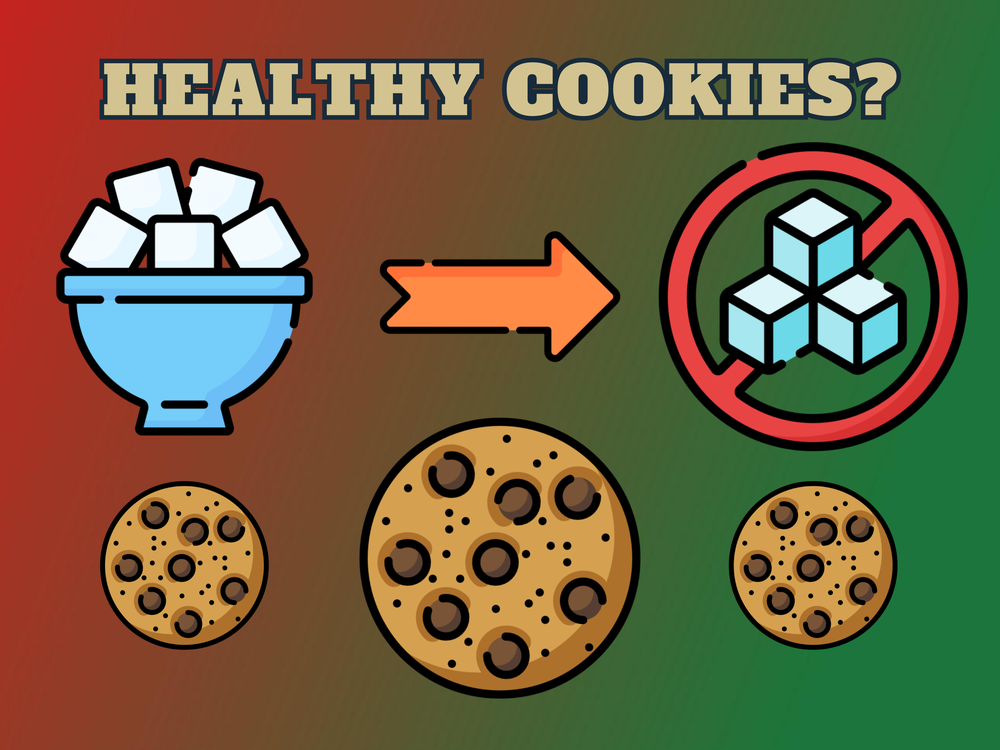
Introduction
I've been wanting to experiment with making healthy versions of classic desserts by swapping out ingredients one by one, analyzing the results, and refining the recipe to end up with a healthier dessert that's as similar as possible to the original product. Today, I'll be tackling chocolate chip cookies, but this will be a 2 part series, with a sister post about brownies. Be sure to check out Making Brownies Healthier when it goes live.


The Problem
Obviously, there's nothing wrong with having a treat like a cookie every now and then. Occasionally at a holiday or gathering, one cookie certainly will not kill you. But if you're someone who has them all the time, then learning to make healthier swaps with minimal difference can be a gamechanger.
For the purposes of this experiment, I will be using my Classic Chocolate Chip Cookies recipe as a starting point. The way I see it, there are 3 health problems with traditional cookies, and most dessert for that matter. These are the following
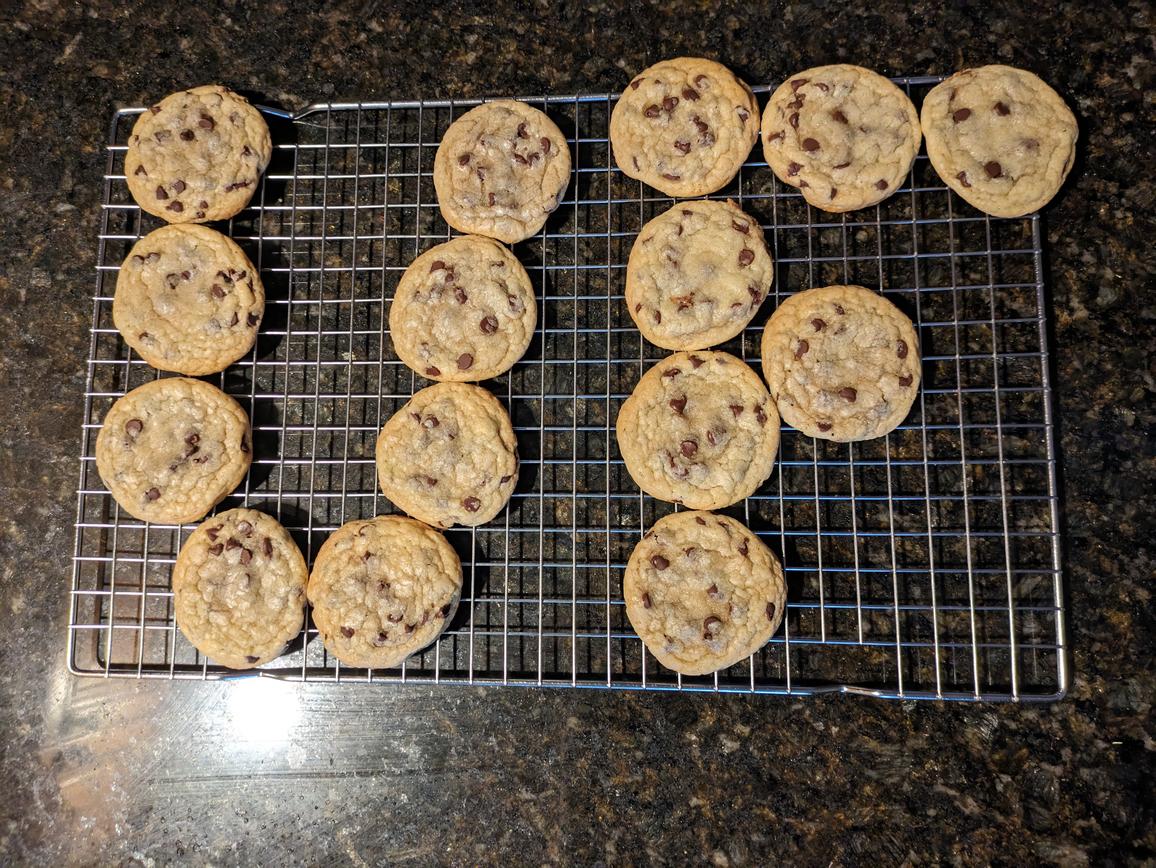

For reference, below are the ingredients and nutrition facts for my Classic Chocolate Chip Cookies. This is just a standard cookie recipe that I make from time to time, and I figured it would be a good starting place:
These cookies are delicious, don't get me wrong. But with 110 calories and 10 g of added sugar for a fairly small cookie, these can't be more than a once a holiday treat for me. How can we bump up these numbers? (or more accurately, bump them down).
------------------------------------------
Batch 1
Here is my first batch. I wanted to tackle the first bullet point right off the bat, as for me this is most glaring flaw, and possibly the easiest to correct. In place of sugar, I will be using allulose, a zero calorie granular natural sweetener. Below is my list of changes from the original recipe:
As mentioned, the main change was swapping sugar for allulose. I also swapped out the molasses and white flour for honey and whole wheat flour. I don't normally have molasses or white flour in my house; I do this swap all the time in standard cookies. Below is the full list of ingredients for batch 1:
Right off the bat, we knocked out most of the sugar and nearly a quarter the calories These cookies are not sugar free through; they still use honey and semi-sweet chocolate chips. There's also still a whole stick of butter, and I'm not wild on the whole wheat flour tbh; we can do better. But this is a good first step.
------------------------------------------
Let's bake it and see how batch #1 holds up. For starters, I should go over a quick mistake I made while baking this batch:
I baked this batch in a 350F for 9 mintues, the same as the original recipe. These cookies definitely didn't spread as much as standard chocolate chip cookies. I believe increased sugar in the dough leads to more spreading, so instead these baked up taller. That's not a bug though, that's a feature. Because of this, the cookies were a little browned and crisp on the outside, while still being gooey in the center. That's a win for me!
But how do they taste? Raw, the cookie dough was definitely slightly less sweet than normal, had a mild cooling feeling from the allulose, and a stronger whole wheat taste. For reference, I normally use whole wheat flour for Classic Chocolate Chip Cookies since I hardly ever buy white flour, and you can barely taste the difference.
When baked though, the cookies browned nicely; they cooked and smelled just like standard chocolate chip cookies. The flavor, texture, and taste were nearly identical to the standard chocolate chip cookie. That may be because of the chocolate chips being unchanged, but this is the best I could hope for in the first batch.

Definite Next Step
The next obvious step is to remove all the added sugar, meaning the honey and the chocolate chips. As there's only 1 tbsp of honey, I think I'll just fully cut it out.
As for the chocolate chips, this is a more difficult problem. Storebought sugar free chocolate chips are more expensive, and can contain other unhealthy additives. I'd rather sacrifice a little bit of flavor and texture and make homemade sugar free chocolate chunks.
The homemade chocolate will melt more than chocolate chips, but again I call that a feature instead of a bug. Melted chocolate means more puddles of chocolate throughout the whole cookie, instead of bites with all or nothing.
Possible Next Steps?
As I found out in Fat Replacements in Boxed Brownies and Sweet Potato Boxed Brownies, sweet potato seemed to be the best butter or oil replacement in brownies. But only in keto brownies, as these still have fat from the almond flour. In standard wheat flour based brownies, the removal of fat leads to a lackluster flavor and texture.
But how does that translate to cookies? Option 2 would be ideal, as it uses more natural ingredients like potatoes and nuts as opposed to oil, and almond flour would be finer as opposed to coarse oat flour. I'll be starting with this route, but I'll make a batch of the first option if this doesn't work out.
Intermission - Chocolate Bar
Back to the drawing board. Firstly, let's tackle the chocolate. I need to have some sort of chocolate chips or chunks for my cookies, so let's make a bar. I'm aiming for semi-sweet chocolate here, which is the following:
A bar of chocolate is essentially just 3 ingredients. Firstly, you have some solid fat, like cocoa butter or coconut oil. Second is the cocoa itself, and lastly is the sweetener. Getting the sugar and fat is the easiest, as all the sugar comes from the sugar, and all the fat comes from the fat. Simple enough.
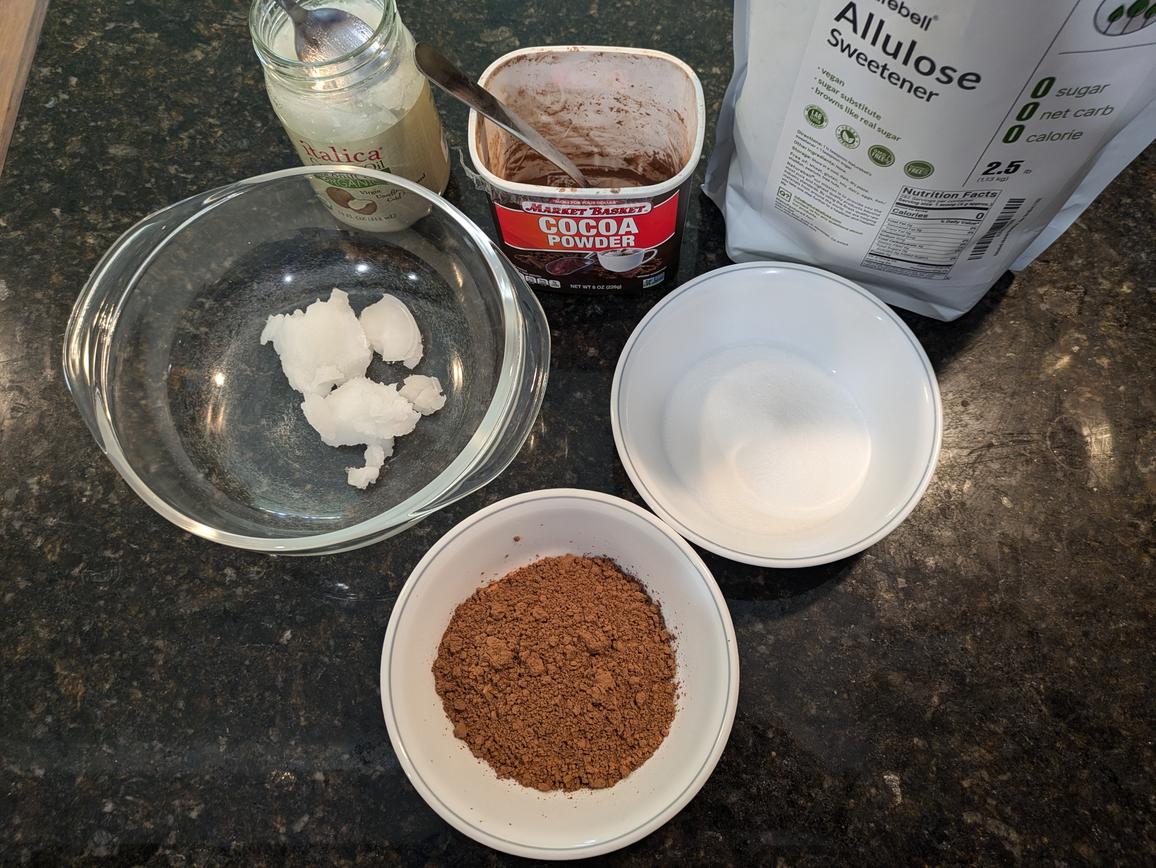
That means, we'll need 6 g of sweetener and 5 g of fat. That leaves us with the remaining 6 g being cocoa powder. If using sugar as the sweetener and coconut oil as the fat, this gets you nearly identical nutrition facts to our original bar. But I'll be going with allulose here instead of sugar. Scaling up to make a full size chocolate bar, we have the following:
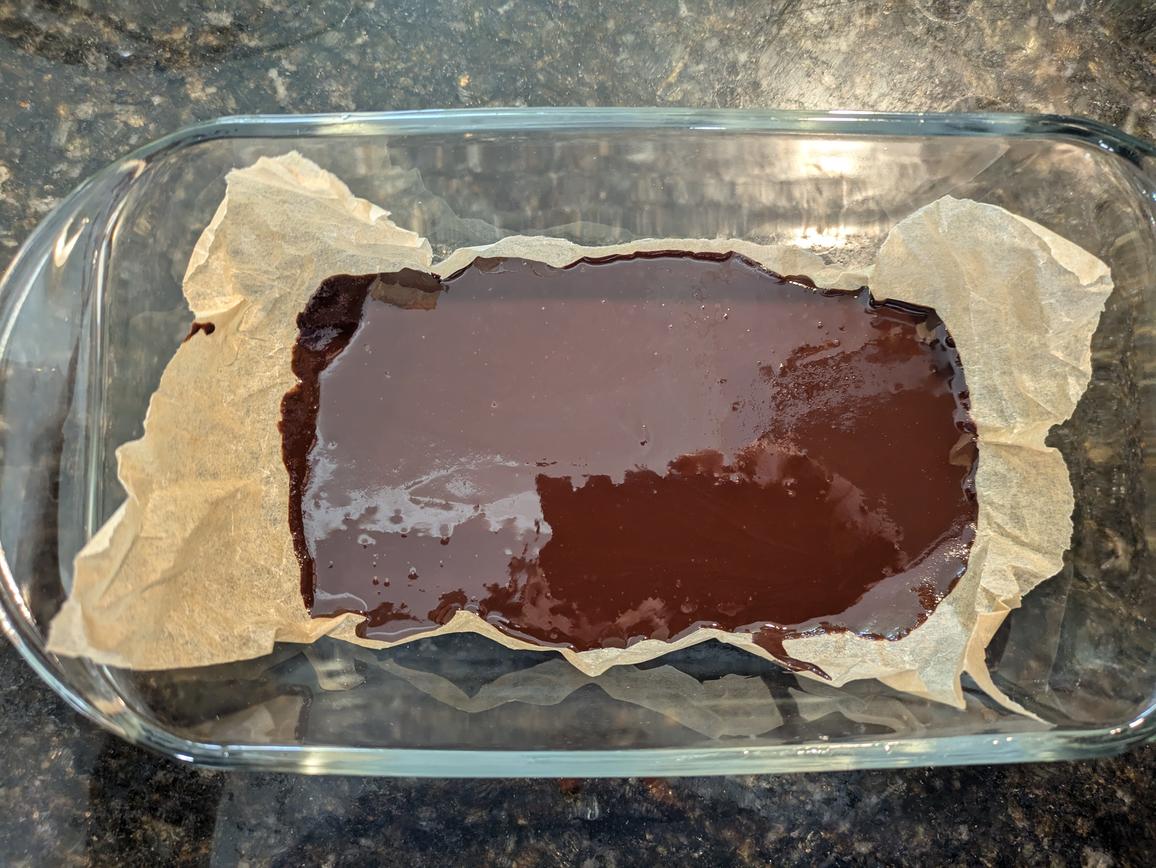
This gets us a bar of chocolate weighting 176 g (about 6 oz). Just melt coconut oil in a bowl, mix in the cocoa and sweetener, and transfer to a chocolate mold or parchment lined bread pan. Refrigerate for an hour to harden, and then chop into chunks.
------------------------------------------
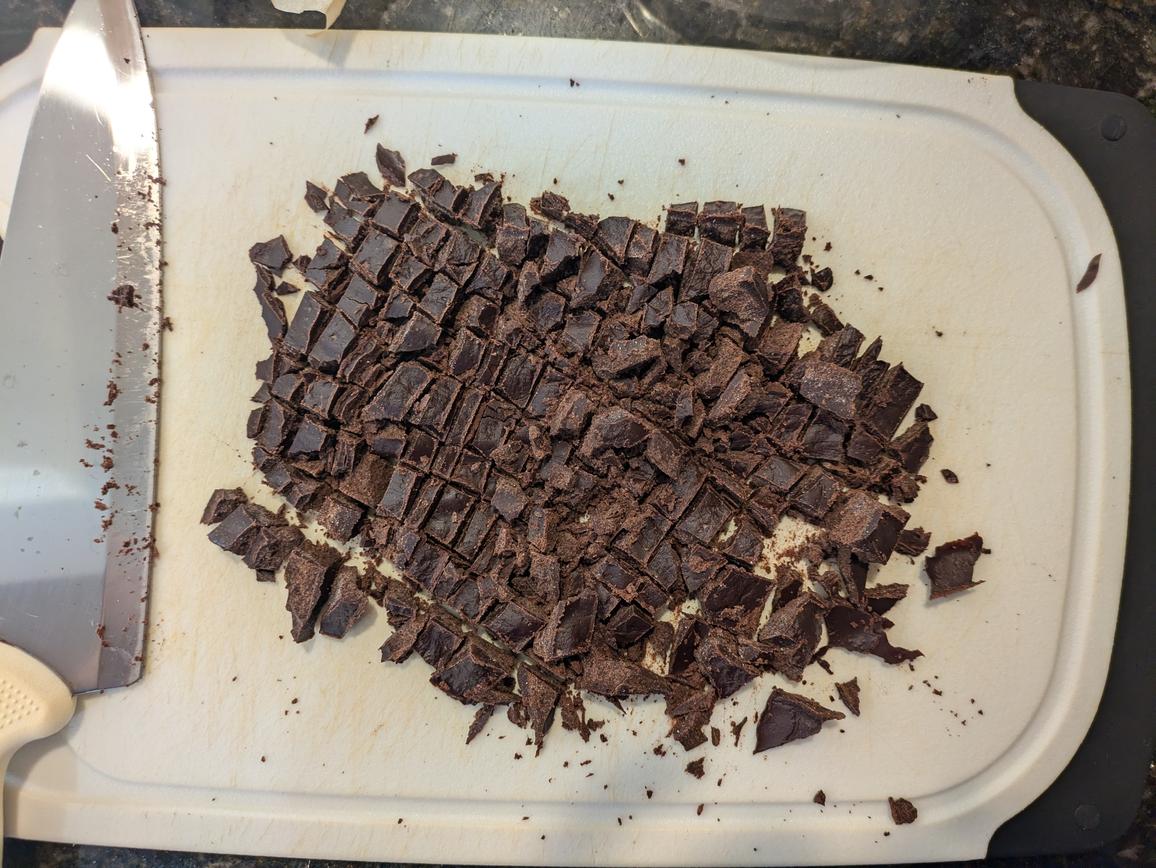
Batch 2
I've made a few changes for the second batch. The main swap here was changing the fat source from butter to almond butter. Below is an outline.:
Peanut butter lowers the fat, adds protein and fiber, and is just an overall much healthier ingredient than butter. Optionally, add 1/2 tsp (2.5 g) butter extract to make up for the lack of butter flavor. Besides this, the other main changes were swapping whole wheat for oat flour, and using homemade chocolate instead of storebought chips. Here's the full recipe:
By cutting out the honey and chocolate chips, we now have fully sugar free cookies. If you want it slightly sweeter, add 1/2 tsp (2.5 g) liquid monk fruit. They're also gluten free too because of the oat flour, and vegan due to the lack of eggs. No eggs and no flour also means that these can safely be enjoyed raw too! They can be nut free as well if you use tahini, pumpkin seed butter, or sunflower seed butter.
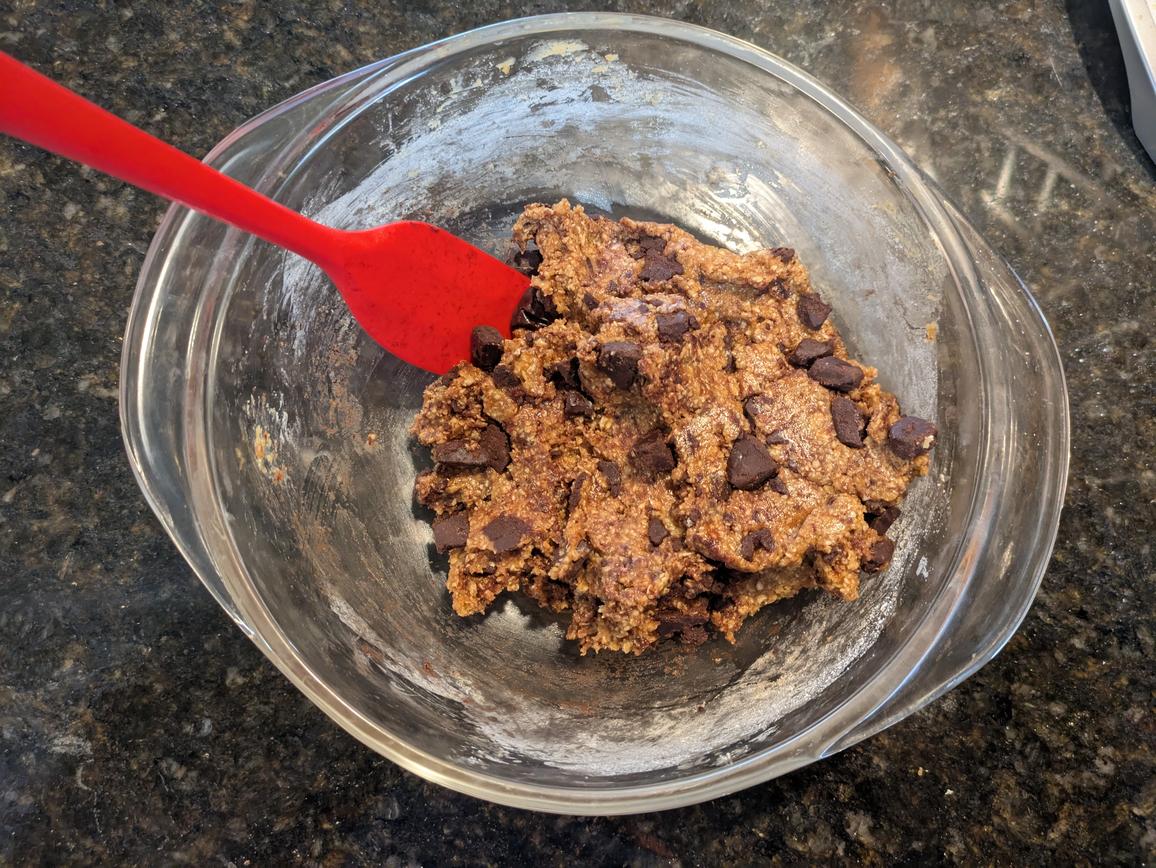
I mixed everything with a silicone spatula, folded in the chopped chocolate, shaped the cookies, flattened them down, and let them rest in the fridge for a few hours before baking for 10 minutes at 350F. I flattened these ones out, since the last batch baked up a little too tall. So how did this batch bake, and how do they look and taste?
Honestly, these were mediocre at best. They were crunchy, not soft, and not sweet. The butter extract didn't do anything, and I would have been better off with sugar free chocolate chips than homemade allulose chocolate. The one good thing I'll say is that oat flour is a better alternative to white flour in cookies than whole wheat flour. It absorbs more water (meaning you'll need less of it), and it has a more mild flavor that doesn't distract from the cookies.
------------------------------------------

Conclusion
Honestly, I won't be baking with allulose again. It loses all it's sweetness when baked, doesn't spread or brown like sugar (despite what it says on the bag), and is expensive. The first batch of cookies was actually fairly solid, but batch #2 was definitely a failure. Both though pale in comparison to any of my other healthier desserts, let alone a batch of regular cookies. Below are some other recipes I'd recommend you try instead of these:
My main takeaway from this honestly though is that I can't digest allulose. Some people are totally fine with it, but other seem to get side effects like an upset stomach, bloating, constipation, nausea, or diarrhea. I personally fall into the latter, getting bloating and a stomach ache from just 1 cookie, so I personally won't be making these again.
Sources
This post may contain affiliate links
I've been wanting to experiment with making healthy versions of classic desserts by swapping out ingredients one by one, analyzing the results, and refining the recipe to end up with a healthier dessert that's as similar as possible to the original product. Today, I'll be tackling chocolate chip cookies, but this will be a 2 part series, with a sister post about brownies. Be sure to check out Making Brownies Healthier when it goes live.


The Problem
Obviously, there's nothing wrong with having a treat like a cookie every now and then. Occasionally at a holiday or gathering, one cookie certainly will not kill you. But if you're someone who has them all the time, then learning to make healthier swaps with minimal difference can be a gamechanger.
For the purposes of this experiment, I will be using my Classic Chocolate Chip Cookies recipe as a starting point. The way I see it, there are 3 health problems with traditional cookies, and most dessert for that matter. These are the following
- Added sugars
- Butter or highly refined oils
- Processed white flour


For reference, below are the ingredients and nutrition facts for my Classic Chocolate Chip Cookies. This is just a standard cookie recipe that I make from time to time, and I figured it would be a good starting place:
- 1 cup (200 g) Granulated sugar
- 1 tbsp (20 g) Molasses
- 1/2 cup, melted (113 g) Unsalted butter
- 1 large (50 g) Egg
- 2 tsp (10 g) Vanilla extract
- 1/2 tsp (3 g) Baking soda
- 1/2 tsp (3 g) Salt
- 2 cup (240 g) All purpose flour
- 1 cup (180 g) Semi-sweet chocolate chips
These cookies are delicious, don't get me wrong. But with 110 calories and 10 g of added sugar for a fairly small cookie, these can't be more than a once a holiday treat for me. How can we bump up these numbers? (or more accurately, bump them down).
------------------------------------------
Total Fat: 4.7g (6 %)
Sodium: 60mg (3 %)
Total Carbohydrate: 16.0g (6 %)
Fiber: 0.6g (2 %)
Net Carbs: 15.4g
Total Sugar: 9.7g
Added Sugar: 9.7g (19 %)
Protein: 1.2g (2 %)
Total Fat: 4.7g (6 %)
Sodium: 60mg (3 %)
Total Carbohydrate: 16.0g (6 %)
Fiber: 0.6g (2 %)
Net Carbs: 15.4g
Total Sugar: 9.7g
Added Sugar: 9.7g (19 %)
Protein: 1.2g (2 %)
Batch 1
Here is my first batch. I wanted to tackle the first bullet point right off the bat, as for me this is most glaring flaw, and possibly the easiest to correct. In place of sugar, I will be using allulose, a zero calorie granular natural sweetener. Below is my list of changes from the original recipe:
- Swapped sugar for allulose at a 1:1 ratio by weight
- Used honey and whole wheat flour instead of molasses and white flour (just what I had on hand)
As mentioned, the main change was swapping sugar for allulose. I also swapped out the molasses and white flour for honey and whole wheat flour. I don't normally have molasses or white flour in my house; I do this swap all the time in standard cookies. Below is the full list of ingredients for batch 1:
- 1 cup (200 g) Allulose
- 1 tbsp (21 g) Honey
- 1 stick, melted (113 g) Unsalted butter
- 1 large (50 g) Egg
- 1 tsp (5 g) Vanilla extract
- 1/2 tsp (3 g) Baking soda
- 1/2 tsp (3 g) Salt
- 1.75 cup (215 g) Whole wheat flour
- 1 cup (180 g) Semi-sweet chocolate chips
Right off the bat, we knocked out most of the sugar and nearly a quarter the calories These cookies are not sugar free through; they still use honey and semi-sweet chocolate chips. There's also still a whole stick of butter, and I'm not wild on the whole wheat flour tbh; we can do better. But this is a good first step.
------------------------------------------
Total Fat: 4.9g (6 %)
Sodium: 65mg (3 %)
Total Carbohydrate: 15.1g (5 %)
Fiber: 1.1g (4 %)
Net Carbs: 7.8g
Total Sugar: 3.3g
Added Sugar: 3.3g (7 %)
Allulose: 6.3g
Protein: 1.4g (3 %)
Total Fat: 4.9g (6 %)
Sodium: 65mg (3 %)
Total Carbohydrate: 15.1g (5 %)
Fiber: 1.1g (4 %)
Net Carbs: 7.8g
Total Sugar: 3.3g
Added Sugar: 3.3g (7 %)
Allulose: 6.3g
Protein: 1.4g (3 %)
Let's bake it and see how batch #1 holds up. For starters, I should go over a quick mistake I made while baking this batch:
- Reduced vanilla extract from 2 tsp to 1 tsp
- This was just a mistake, I meant to do 2 tsp, but followed the recipe wrong. We're all human
I baked this batch in a 350F for 9 mintues, the same as the original recipe. These cookies definitely didn't spread as much as standard chocolate chip cookies. I believe increased sugar in the dough leads to more spreading, so instead these baked up taller. That's not a bug though, that's a feature. Because of this, the cookies were a little browned and crisp on the outside, while still being gooey in the center. That's a win for me!
But how do they taste? Raw, the cookie dough was definitely slightly less sweet than normal, had a mild cooling feeling from the allulose, and a stronger whole wheat taste. For reference, I normally use whole wheat flour for Classic Chocolate Chip Cookies since I hardly ever buy white flour, and you can barely taste the difference.
When baked though, the cookies browned nicely; they cooked and smelled just like standard chocolate chip cookies. The flavor, texture, and taste were nearly identical to the standard chocolate chip cookie. That may be because of the chocolate chips being unchanged, but this is the best I could hope for in the first batch.

Definite Next Step
- Replace the honey
- Replace it with sugar free syrup?
- Or just omit it?
- Replace the chocolate chips
- Use storebought sugar free chocolate chips?
- Or make a homemade sugar free chocolate?
The next obvious step is to remove all the added sugar, meaning the honey and the chocolate chips. As there's only 1 tbsp of honey, I think I'll just fully cut it out.
As for the chocolate chips, this is a more difficult problem. Storebought sugar free chocolate chips are more expensive, and can contain other unhealthy additives. I'd rather sacrifice a little bit of flavor and texture and make homemade sugar free chocolate chunks.
The homemade chocolate will melt more than chocolate chips, but again I call that a feature instead of a bug. Melted chocolate means more puddles of chocolate throughout the whole cookie, instead of bites with all or nothing.
Possible Next Steps?
- Replace the butter for coconut oil, and swap the wheat flour for oat flour
- Replace the butter for some lower fat replacement, and swap the wheat flour for almond flour
As I found out in Fat Replacements in Boxed Brownies and Sweet Potato Boxed Brownies, sweet potato seemed to be the best butter or oil replacement in brownies. But only in keto brownies, as these still have fat from the almond flour. In standard wheat flour based brownies, the removal of fat leads to a lackluster flavor and texture.
But how does that translate to cookies? Option 2 would be ideal, as it uses more natural ingredients like potatoes and nuts as opposed to oil, and almond flour would be finer as opposed to coarse oat flour. I'll be starting with this route, but I'll make a batch of the first option if this doesn't work out.
Intermission - Chocolate Bar
Back to the drawing board. Firstly, let's tackle the chocolate. I need to have some sort of chocolate chips or chunks for my cookies, so let's make a bar. I'm aiming for semi-sweet chocolate here, which is the following:
A bar of chocolate is essentially just 3 ingredients. Firstly, you have some solid fat, like cocoa butter or coconut oil. Second is the cocoa itself, and lastly is the sweetener. Getting the sugar and fat is the easiest, as all the sugar comes from the sugar, and all the fat comes from the fat. Simple enough.

That means, we'll need 6 g of sweetener and 5 g of fat. That leaves us with the remaining 6 g being cocoa powder. If using sugar as the sweetener and coconut oil as the fat, this gets you nearly identical nutrition facts to our original bar. But I'll be going with allulose here instead of sugar. Scaling up to make a full size chocolate bar, we have the following:
- 1/4 cup (54 g) Extra virgin coconut oil
- 1/2cup + 2tbsp (50 g) Cocoa powder
- 6 tbsp (72 g) Allulose

This gets us a bar of chocolate weighting 176 g (about 6 oz). Just melt coconut oil in a bowl, mix in the cocoa and sweetener, and transfer to a chocolate mold or parchment lined bread pan. Refrigerate for an hour to harden, and then chop into chunks.
------------------------------------------
Total Fat: 5.2g (7 %)
Sodium: 1mg (0 %)
Total Carbohydrate: 8.4g (3 %)
Fiber: 1.5g (6 %)
Net Carbs: 0.9g
Total Sugar: 0.1g
Allulose: 6.0g
Protein: 0.8g (2 %)
Total Fat: 5.2g (7 %)
Sodium: 1mg (0 %)
Total Carbohydrate: 8.4g (3 %)
Fiber: 1.5g (6 %)
Net Carbs: 0.9g
Total Sugar: 0.1g
Allulose: 6.0g
Protein: 0.8g (2 %)

Batch 2
I've made a few changes for the second batch. The main swap here was changing the fat source from butter to almond butter. Below is an outline.:
- Swapped 1 stick (113 g) butter for 1/2 cup (128 g) peanut butter
- Omitted honey
- Use correct amount of vanilla extract
- Swapped whole wheat flour for oat flour
- Used the homemade allulose sweetened chocolate
- Used a flax egg instead of a real egg
- (Main reason) I was out of eggs
- Vegan
- Can be eated raw
- Easier to scale
Peanut butter lowers the fat, adds protein and fiber, and is just an overall much healthier ingredient than butter. Optionally, add 1/2 tsp (2.5 g) butter extract to make up for the lack of butter flavor. Besides this, the other main changes were swapping whole wheat for oat flour, and using homemade chocolate instead of storebought chips. Here's the full recipe:
- 1 cup (200 g) Allulose
- 1/2 cup, melted (128 g) Natural peanut butter
- 1 tbsp (6.5 g) Ground flaxseed
- 3 tbsp (45 g) Water
- 2 tsp (10 g) Vanilla extract
- 1/2 tsp (3 g) Baking soda
- 1/2 tsp (3 g) Salt
- 2 cup (180 g) Oat flour
- 1 cup, chopped (180 g) Allulose chocolate bar
By cutting out the honey and chocolate chips, we now have fully sugar free cookies. If you want it slightly sweeter, add 1/2 tsp (2.5 g) liquid monk fruit. They're also gluten free too because of the oat flour, and vegan due to the lack of eggs. No eggs and no flour also means that these can safely be enjoyed raw too! They can be nut free as well if you use tahini, pumpkin seed butter, or sunflower seed butter.

I mixed everything with a silicone spatula, folded in the chopped chocolate, shaped the cookies, flattened them down, and let them rest in the fridge for a few hours before baking for 10 minutes at 350F. I flattened these ones out, since the last batch baked up a little too tall. So how did this batch bake, and how do they look and taste?
Honestly, these were mediocre at best. They were crunchy, not soft, and not sweet. The butter extract didn't do anything, and I would have been better off with sugar free chocolate chips than homemade allulose chocolate. The one good thing I'll say is that oat flour is a better alternative to white flour in cookies than whole wheat flour. It absorbs more water (meaning you'll need less of it), and it has a more mild flavor that doesn't distract from the cookies.
------------------------------------------
Total Fat: 4.4g (6 %)
Sodium: 78mg (3 %)
Total Carbohydrate: 14.2g (5 %)
Fiber: 1.5g (5 %)
Net Carbs: 4.1g
Total Sugar: 0.4g
Allulose: 8.6g
Protein: 2.1g (4 %)
Total Fat: 4.4g (6 %)
Sodium: 78mg (3 %)
Total Carbohydrate: 14.2g (5 %)
Fiber: 1.5g (5 %)
Net Carbs: 4.1g
Total Sugar: 0.4g
Allulose: 8.6g
Protein: 2.1g (4 %)

Conclusion
Honestly, I won't be baking with allulose again. It loses all it's sweetness when baked, doesn't spread or brown like sugar (despite what it says on the bag), and is expensive. The first batch of cookies was actually fairly solid, but batch #2 was definitely a failure. Both though pale in comparison to any of my other healthier desserts, let alone a batch of regular cookies. Below are some other recipes I'd recommend you try instead of these:
My main takeaway from this honestly though is that I can't digest allulose. Some people are totally fine with it, but other seem to get side effects like an upset stomach, bloating, constipation, nausea, or diarrhea. I personally fall into the latter, getting bloating and a stomach ache from just 1 cookie, so I personally won't be making these again.
Sources